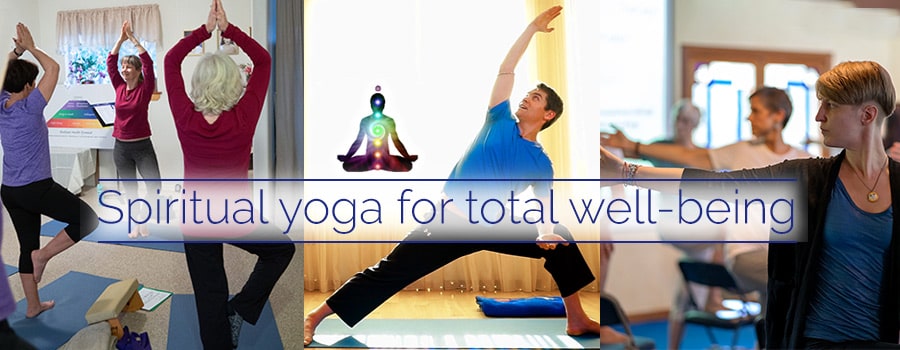|
This article was written for the Ananda Yoga® Teacher Association newsletter. Learn more, or find a certified Ananda Yoga® teacher near you. |
Rewire Your Circuits
Recently, Swami Kriyananda said something that is very relevant for yoga teachers:
“In anything we do, we should never take credit to ourselves. It’s what we do that makes us the way we are, and if we did differently, we’d be different. We are the result, not of talents, gifts, or qualities, but of actions that reflect those qualities.
“When you don’t do well and you aren’t feeling good about yourself, it’s very important to think in terms of ‘What can I change, not in my qualities, but in the way I do things?’ It’s a matter of how you treat the world, of how you treat other people, of whether you’re putting out energy to serve others or drawing their energy back to you, to your ego.”
This is a very freeing thought: our character qualities (“good” or “bad”) may describe us at a given moment, but they don’t define or limit us.
We have a quality because energy flows through us in a particular way — because that’s it’s flowed in the past. To change the quality, change the flow. If we express the quality through action, we strengthen it; if we don’t, it withers.
As Paramhansa Yogananda often said, “The instrument is blessed by that which flows through it.” It’s a very potent, direct means to change ourselves: change our actions.
And it’s not just what we do, but how we do it. Two teachers can give identical classes, with identical words and actions. But if one gives selflessly to the students while the other tries to draw energy from the students (trying to get their approval, admiration, etc.), the results will be quite different — both for the teachers and for their students.
The first teacher will expand, and her students will feel empowered: “I can do this!” The second teacher will contract, and her students will feel diminished in some way: “She’s so wonderful! (… and I’m not.)”
The Mechanics of Transformation
Yoga says that the actions that mold us are not only outward, but thoughts, emotions, motives, and desires — via the energy that animates them. In this article, I’ll explore how this inner transformation can manifest on the physical level, and how that’s relevant to the practice and teaching of Ananda Yoga®.
In his popular “brain class” at The Expanding Light, Dr. Peter Van Houten describes how the brain remains highly “plastic” throughout life. For example, suppose you begin to practice a musical instrument every day. In response to this new regular practice, the “musical part” of the brain literally begins add new neurons and develop new neural pathways. The brain becomes “more musical.”
Thus the adage “practice makes perfect” is about more than just gaining familiarity with some activity. It’s about enlarging and rewiring the brain to facilitate this new activity. Echoing Swami Kriyananda’s words, we change the brain through the ways in which we use it. The expression, “Use it or lose it,” has a positive side: “Use it and grow it.”
Mind into Muscle?
I’ve recently come across some interesting research on the topic of how thought can change us. Dave Smith, a sports psychologist in England, is a former strength training coach who has used visualization to improve his clients’ strength gains.
This is not new; top athletes all over the world use visualization. But Dave wanted to prove the value of this practice, so he conducted an experiment to determine whether “mental workouts” — i.e., sitting still and visualizing oneself lifting weights — truly build strength. He gave each of three groups of men a different training regime: actual strength training, mental workouts (only), or nothing at all.
After four weeks, the first group showed a 33% strength increase, the second showed a 16% increase, and the third group showed no change. That’s right: mental workouts are half as effective as physical workouts!
Keys to Visualization
Dr. Smith’s prescription for how to do a mental workout is instructive. To be effective, he says, mental workouts must (a) be regular, and (b) take a particular approach to visualization.
A mental workout shouldn’t be like watching a home movie of yourself: “There’s me, on my mental movie screen, lifting a 300-pound barbell.” Instead, he emphasizes engaging all the senses: “Recreate the entire experience in your mind. Make it as much like actual weightlifting as possible: imagine your muscles straining and getting ‘pumped up,’ heart pounding, sweat dripping. In every way, feel yourself doing it right now!” He even encourages clients to wear their workout clothes during mental workouts, and to imagine the smell of the gym (how lovely!).
One reason that this approach works is that the motor parts of the brain (i.e., those concerned with moving your body) can’t tell the difference between visualization and actuality. Their job is to get neurons to fire in the brain; they have no way of knowing whether the firing actually causes any physical movement. (Other parts of the brain do know whether there is movement, however.) If we do a convincing job of visualization, the motor parts of the brain will believe that the workout is really happening.
As a result, the nervous system changes: Dr. Smith has found that strength gains from mental workouts are primarily due to improvements in neural pathways in the brain, spinal cord, and peripheral nervous system that control the movements involved. Yes, it takes physical strength training to increase muscle size, but mental workouts can rewire us for more efficient application of our muscle power.
In addition to demonstrating brain plasticity, this makes a strong argument for controlling our mental processes. Anything we do, even mentally, is literally reshaping our brains so we can do that better, more easily, and more naturally — whether it leads us to happiness or not. So let’s not leave our minds unchaperoned!
A Note on Energization
The Energization Exercises (EE's) take it a step farther: they employ both physical exertion and visualization. So it seems safe to extrapolate from Dr. Smith’s research and say that the EE’s are an effective strength training regime if — and this is a big “if” — they are done correctly: with great will power and concentration. (Anyone who’s ever tried the Charles Atlas Dynamic Tension System of bodybuilding will concur. It’s very much like Energization. In fact, Charles Atlas was a student of Yogananda’s teachings.)
Of course, strength is not the goal of the EE’s. And the visualization technique is different: instead of visualizing muscles contracting, heart pounding, sweat dripping, etc., we visualize sending and withdrawing energy. But I’ll wager that those elements of Dr. Smith’s prescription are simply indirect ways to foster concentration and engage the will and feeling capacity.
In Energization, we focus directly on using will and feeling — “Tense with will, relax and feel.” Seems to me that such a direct focus might produce better results, even just at the level of physical strength. Maybe this will inspire you in your Energization practice. Or maybe (and I hope) you’re looking for more than just strength from the EE’s. So let’s go a bit deeper.
How about a Plastic Heart?
Recent research has shown that the heart is not just a specialized muscle. Neurocardiologists have found that 60 – 65% of the heart’s cells are neural cells — exactly like brain cells, with the same types of connections and neurotransmitters.
That’s right: your heart is mostly brain, and it constantly converses with the “emotional brain” (i.e., the limbic system and its attendant structures, such as the amygdala and hippocampus). The emotional brain tells the heart about your experience of the world, from a “how do I feel about this?” perspective. The heart responds by telling the emotional brain what to do about it — e.g., fight or flee. In fact, the heart’s responses generate a powerful electromagnetic field that influences the entire body, and in particular, the brain.
This may be an outward manifestation of an important inner truth that Paramhansa Yogananda often cited: “Reason follows feeling.” That is, the intellect tends to look for — and find — ways to justify what we are feeling emotionally.
Next time you find yourself justifying some behavior of yours, check to see if you might simply be defending an emotional response. Perhaps your heart’s magnetic field is lending physiological bias to your brain function, swaying the brain to align with the emotional response. That’s mere speculation on my part, but it certainly seems possible.
So science already knows that when the mind expresses in a particular way, the brain grows and reshapes itself to facilitate that particular expression. Well, if the heart is largely a brain itself, might not the same thing happen with the heart? And if our feeling capacity expresses outwardly through the physical “heart brain” and emotional brain, might our exercise of feeling rewire the heart and brain to be better instruments to express feeling?
I wouldn’t be surprised, even though it’s not been proven physiologically. The yoga teachings back it up in this sense: when we do something regularly with the mind or feeling capacity, it becomes easier and more natural to do it. And the more feeling we put into it, the easier and more natural it becomes — whether it leads us to happiness or not! “I joyfully manifest the power of God!”
All of this ties in directly with Ananda Yoga practice. For example, the energy awakened within us by an asana has a particular quality to it: joy, or peace, or love, etc. That energy flow will transform us according to the quality of the energy, the strength of the flow, and the amount of time we spend channeling it through us.
So Ananda Yoga is a perfect example of self-transformation through what we do. Now we can more easily see the power of affirmations. They help transform us by strengthening the energy flow, helping us more deeply experience divine joy, peace, love, etc., that are promoted by particular asanas. But it takes true affirmation, not mere mental repetition, which is like the mental movies that Dr. Smith mentioned: perhaps beneficial, but not especially powerful.
The real key to affirmation is to directly engage all of yourself in the practice — not the senses, as Dr. Smith counsels for strength training, but your feeling capacity, intellect, and will.
In this way, we begin to take control over our inner energies, to bring them inward and upward. With practice, we get better and better at doing that because we literally rewire our inner circuitry to facilitate it. And yogis would say that this inner circuitry is not just our physical nervous systems, but our astral nervous systems as well.
This also suggests a way to practice asanas when we can’t attain the full pose due to injury or inflexibility: use visualization — and use it strongly. Make it a body/mind/ feeling experience, not just a mental movie.
Take what you know from experience — perhaps from other occasions when you could do the pose better, or from similar poses that you can do — and use mental imagery combined with willpower and feeling to go deeper into the pose on nonphysical levels. Visualize more physical opening, stronger energy flows, and above all, a deeper experience of the associated psychospiritual qualities. It really works!
A Key to Teaching Ananda Yoga®
All of this shows clearly the value of teaching Ananda Yoga with deep feeling. If we will magnetically invite our students into their own realistic feeling experiences, we’ll create an atmosphere in which they can fully absorb themselves in the qualities of the affirmations.
That can’t be done through pretending. We must ourselves be in — and radiate — those qualities. The more we experience them, the more we will convey them on a vibrational level through everything we do in our teaching: our words, our touch, even our modeling of the poses. It’s not about talking loud or having a forceful or dramatic teaching personality; it’s about being in those states, and teaching from those states.
This means experiencing those states in our own practice of asana and meditation. It means becoming so familiar with them that we can tune in to them while teaching, even if we’re not doing the poses ourselves. It means, when we offer the asana affirmations to our students, offering them with vibrant feeling. Make them so natural, so inviting, so magnetic, that students will want to dive in.
When we do this, we’ll be giving our students the key to their own higher experiences from their practice — and a valuable tool for “rewiring themselves” for their own highest happiness.
All authors are graduates of Ananda Yoga Teacher Training.





















